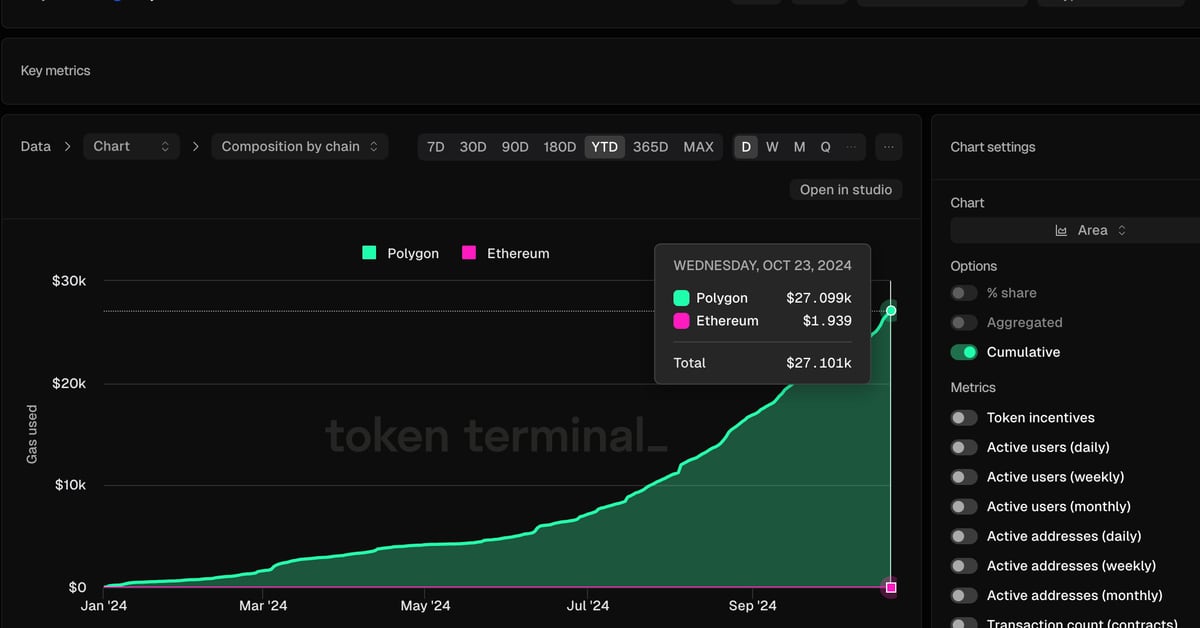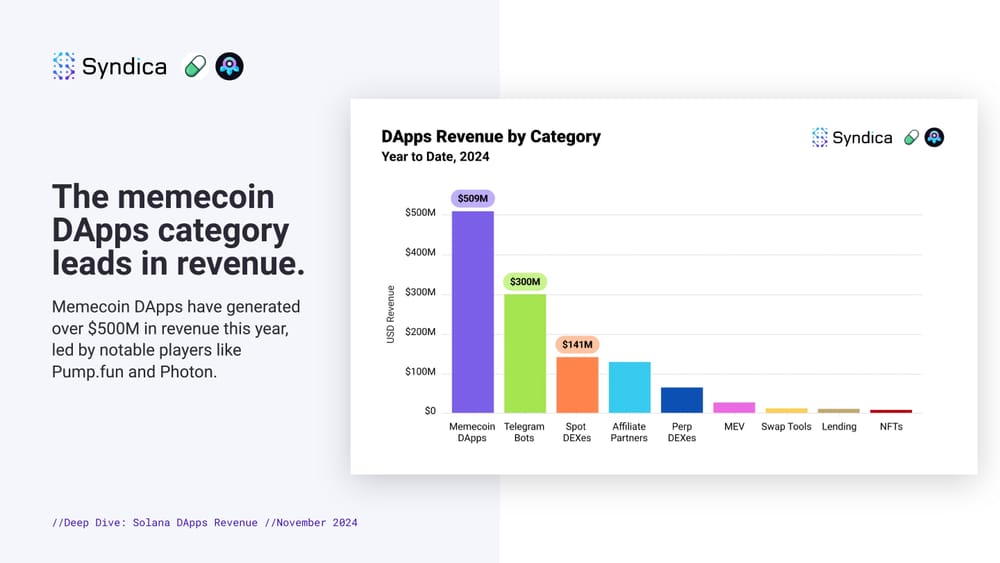Dapps
Polymarket Is a Success for Polygon Blockchain – Everywhere But the Bottom Line
Published
2 months agoon
By
admin

“Now, that’s very different from, let’s say there’s somebody who comes and builds an order book DEX on Polygon PoS,” he said. “If they were doing $20,000 of fees over multiple months, it would be a massive failure, because you would expect massive numbers of orders placed and canceled and filled, then that would drive huge numbers of transactions. So the key here is like, different applications have different intended purposes.”
Source link
You may like


Tron’s Justin Sun Offloads 50% ETH Holdings, Ethereum Price Crash Imminent?


Investors bet on this $0.0013 token destined to leave Cardano and Shiba Inu behind


End of Altcoin Season? Glassnode Co-Founders Warn Alts in Danger of Lagging Behind After Last Week’s Correction


Can Pi Network Price Triple Before 2024 Ends?


XRP’s $5, $10 goals are trending, but this altcoin with 7,400% potential takes the spotlight


CryptoQuant Hails Binance Reserve Amid High Leverage Trading
Dapps
Meme coins drive Solana DApp revenue to $365m record
Published
4 days agoon
December 18, 2024By
admin
Decentralized application revenue on Solana reached a new record high, mainly generated from meme coin-related transactions and tools.
According to Syndica’s research, Solana (SOL) native DApps garnered $365 million in revenue during November 2024, a new monthly high for the popular layer-1 blockchain network.
Solana’s decentralized finance ecosystem was the leading port of call for revenue. SOL DeFi comprised almost 84% of cash raised last month, compared to wallets and infrastructure, which attracted less than 15%.
Among DeFi activity, meme coins and meme-supportive protocols dominated SOL revenue. Meme coin DApps monthly revenue surged 305-fold in 2024, raking in over $500 million. Pump.fun, crypto’s most popular meme token launch pad, led Solana protocol revenue last month with $106 million, a first for the young project.

Telegram bots solidified their presence within SOL’s ecosystem. The category has amassed the second biggest revenue stream after meme coin DApps, recording over $300 million this year. Meme traders regularly tap bots like Trojan, Banana Gun, and BONKbot to invest in new trendy launches directly from Pavel Durov’s private messaging platform.
Meme coins and meme coin DApps may be Solana’s main characters, but the ecosystem rapidly expanded to include several active players. Syndica’s research reported a parabolic jump in “high-quality players” within SOL’s ecosystem. Researchers noted an increase in protocols earning over $10,000 to $10 million monthly revenue.
The report highlighted SOL’s Decentralized Physical Infrastructure as a major sector in the early stages of revenue generation. DePIN, as crypto natives call it, refers to maintaining and providing real-world services like servers using individual blockchain resources.
Protocols such as Render, Nosana, Helium, and Hivemapper have recently seen strong demand for their services, driving notable revenue growth. Render’s decentralized compute network is currently the largest revenue driver in the DePIN sector.
Syndica report
Source link
Blockchain
DeFi needs more interoperability, not apps or infra
Published
3 months agoon
September 14, 2024By
admin
Disclosure: The views and opinions expressed here belong solely to the author and do not represent the views and opinions of crypto.news’ editorial.
DeFi has too much infrastructure and not enough apps—or at least, that’s what the consensus seems to be in crypto’s town square. Just this year, venture capitalists and private equity investors have poured hundreds of millions of dollars into crypto projects that make infrastructure a priority, if not an exclusive focus.
The highlight reel speaks for itself. In the first quarter alone, VC firm a16z committed $100 million to Eigen Layer, a restaking protocol and infrastructure layer for the Ethereum network; private equity firms Bridgewater Capital and Deus X Capital joined forces to fund a $250 million infrastructure platform; and RW3 Ventures raised $60 million for a fund focused exclusively on blockchain infrastructure and DeFi. These headlines are just a few of many; a quick perusal of any crypto news outlet reveals countless similar announcements.
Focus on infrastructure
The laser focus on infrastructure sparked considerable conversation during and following the Ethereum Community Conferences, or EthCC’24, in mid-July, with many coming to the same conclusion: We need more apps and less emphasis on infrastructure.
It’s a valid perspective on the surface. To put the issue into metaphor, focusing disproportionately on infrastructure is like building the best theme park ever seen—without the rides. Who cares if the park has nice paths, sleek gift shops, and well-equipped food stalls? If you don’t have a roller coaster (or five) on the premises, no one will show up, let alone pay to play.
Theoretical value and potential can only inspire so much customer adoption. A wide variety and deep volume of apps could help hook and retain DeFi users. With more options on offer, users will have more reason and opportunity to not only onboard but also explore.
The problem? Increasing the number of apps can only help the underlying issue (e.g., the long-term growth and sustainability of the DeFi ecosystem) so much. Returning to our metaphor, a good theme park needs a variety of rides to attract guests; however, if those rides are inconvenient to access or unpleasant to experience, interest will taper off sharply.
The real problem: UX
Here, we come to the real problem at the heart of the apps vs. infra debate: user experience.
To say that the DeFi ecosystem (and the emerging BTCFi sector in particular) isn’t intuitive for layperson users would be an almost comical understatement. Even seemingly simple acts such as moving assets between dapps in different ecosystems can become a time-sucking, frustrating exercise for ordinary users. Despite being fundamental to cross-chain transactions, bridging and swapping are virtually impossible for crypto newcomers to figure out without professional guidance. It’s hard to blame a layperson for giving up midway—or opting not to try in the first place.
Infrastructure is meant to enable dApps to seamlessly onboard users, yet the BTCfi ecosystem still grapples with fragmentation issues between various Bitcoin (BTC) variants. While crypto has made progress on interoperability, the user experience remains complex. Traditional bridges and platforms still pose significant limitations and frustrations regarding scalability, slippage, MEV problems, TVL honeypots, and slow and expensive transactions.
The “we need apps, not infra” debate fundamentally misses the point of dApp and infra development by seeking to prioritize one over the other. The number of infra projects doesn’t matter; their quality and impact do.
To be fair, few set out to create a low-impact infra project. DeFi is characterized by its pioneering culture; many dApps are the first of their kind and require their innovators to build appropriate infrastructure rails from scratch.
But, as it is in any race, not everyone can be a winner, and unfortunately, many infra projects today are not and may never be impactful. The days of developing projects for DeFi devotees willing to dedicate time to learning how to use a dapp are fast fading into history. DeFi is approaching its mainstream era—and the amateur users we seek to attract won’t tolerate poor UX or care about underlying infra. To reframe into a common experience: if you’re booking an Uber ride, you don’t care whether the Uber platform runs on AWS or Google Cloud; you just want to get from A to B.
Users first
With this in mind, our end goal should be to have robust infra and abstract it away from a user so they can make full use of their dApps without thinking too hard about how it works. Navigating the DeFi ecosystem—and every app within it—should feel seamless to the point of being intuitive for users. At a minimum, we must simplify interoperability by enabling fast, zero-slippage, MEV-resistant, secure swaps with consistently excellent UX. Next, infra-abstraction must be prioritized; users should never need to see the cogs in the metaphorical machine.
This is possible, and intent-based architecture provides a model for user-centric development in DeFi. Unlike conventional blockchain architecture, which requires users to follow a series of often complex steps to achieve a goal, intent-based architecture seeks to put users first. With this approach, users can state their objective (e.g., make a purchase in a BTCFi app using funds stored on Ethereum) and rely on the blockchain protocol to autonomously complete the technical steps required to achieve that directive. Intent-based models could, if applied widely, go a long way towards ensuring infra-abstraction while improving user experiences and simplifying architecture.
Of course, intent-based architecture isn’t a silver bullet. Projects and protocols must collaborate closely to develop integrations that guarantee seamless interoperability and abstract away operational complexities that users may find overwhelming. Innovators will need to build with amateur users in mind rather than crypto natives with technical knowledge.
It’s time to set aside the infra vs. apps debate and focus on what matters most: the users. Most users probably don’t pay attention to architecture design or care about the investment divide between app and infrastructure projects as long as they follow high-security standards and get the job done. They want blockchain-based finance to be accessible and easy to understand; consumers need to be able to use apps, process transactions, and find new ways to use and make money with DeFi. As innovators and advocates for DeFi’s potential, it falls to us to (re)create the ecosystem into a welcoming world that even amateur users can explore without feeling confused, overwhelmed, or demoralized.
Let’s stop counting infra projects and start making them count instead.

Jeroen Develter
Jeroen Develter is the chief operating officer at Persistence Labs and a seasoned professional in both finance and tech start-up environments. With a decade of international experience in consulting, management, entrepreneurship, and leadership, Jeroen excels at analyzing complex business cases, establishing streamlined operations, and creating scalable processes. With Persistence, Jeroen oversees all product and engineering efforts and is deeply passionate about enhancing Bitcoin defi, or BTCfi, adoption and using intents to develop scalable, fast, secure, and user-friendly solutions. His work at Persistence Labs addresses the significant interoperability challenges between Bitcoin L2s. In addition, Jeroen is also a co-host of the Stacked Podcast, a platform for gaining knowledge about Bitcoin and crypto from prominent Bitcoin builders.
Source link

Tron’s Justin Sun Offloads 50% ETH Holdings, Ethereum Price Crash Imminent?

Investors bet on this $0.0013 token destined to leave Cardano and Shiba Inu behind

End of Altcoin Season? Glassnode Co-Founders Warn Alts in Danger of Lagging Behind After Last Week’s Correction

Can Pi Network Price Triple Before 2024 Ends?

XRP’s $5, $10 goals are trending, but this altcoin with 7,400% potential takes the spotlight

CryptoQuant Hails Binance Reserve Amid High Leverage Trading

Trump Picks Bo Hines to Lead Presidential Crypto Council

The introduction of Hydra could see Cardano surpass Ethereum with 100,000 TPS

Top 4 Altcoins to Hold Before 2025 Alt Season

DeFi Protocol Usual’s Surge Catapults Hashnote’s Tokenized Treasury Over BlackRock’s BUIDL

DOGE & SHIB holders embrace Lightchain AI for its growth and unique sports-crypto vision

Will Shiba Inu Price Hold Critical Support Amid Market Volatility?

Chainlink price double bottoms as whales accumulate

Ethereum Accumulation Address Holdings Surge By 60% In Five Months – Details

Ripple Transfers 90M Coins, What’s Happening?
182267361726451435

Why Did Trump Change His Mind on Bitcoin?

Top Crypto News Headlines of The Week

New U.S. president must bring clarity to crypto regulation, analyst says

Will XRP Price Defend $0.5 Support If SEC Decides to Appeal?

Bitcoin Open-Source Development Takes The Stage In Nashville

Ethereum, Solana touch key levels as Bitcoin spikes

Bitcoin 20% Surge In 3 Weeks Teases Record-Breaking Potential

Ethereum Crash A Buying Opportunity? This Whale Thinks So

Shiba Inu Price Slips 4% as 3500% Burn Rate Surge Fails to Halt Correction

Washington financial watchdog warns of scam involving fake crypto ‘professors’

‘Hamster Kombat’ Airdrop Delayed as Pre-Market Trading for Telegram Game Expands

Citigroup Executive Steps Down To Explore Crypto
Mostbet Güvenilir Mi – Casino Bonus 2024

NoOnes Bitcoin Philosophy: Everyone Eats
Trending

 3 months ago
3 months ago182267361726451435

 Donald Trump5 months ago
Donald Trump5 months agoWhy Did Trump Change His Mind on Bitcoin?

 24/7 Cryptocurrency News4 months ago
24/7 Cryptocurrency News4 months agoTop Crypto News Headlines of The Week

 News4 months ago
News4 months agoNew U.S. president must bring clarity to crypto regulation, analyst says

 Price analysis4 months ago
Price analysis4 months agoWill XRP Price Defend $0.5 Support If SEC Decides to Appeal?

 Opinion5 months ago
Opinion5 months agoBitcoin Open-Source Development Takes The Stage In Nashville

 Bitcoin5 months ago
Bitcoin5 months agoEthereum, Solana touch key levels as Bitcoin spikes

 Bitcoin5 months ago
Bitcoin5 months agoBitcoin 20% Surge In 3 Weeks Teases Record-Breaking Potential


